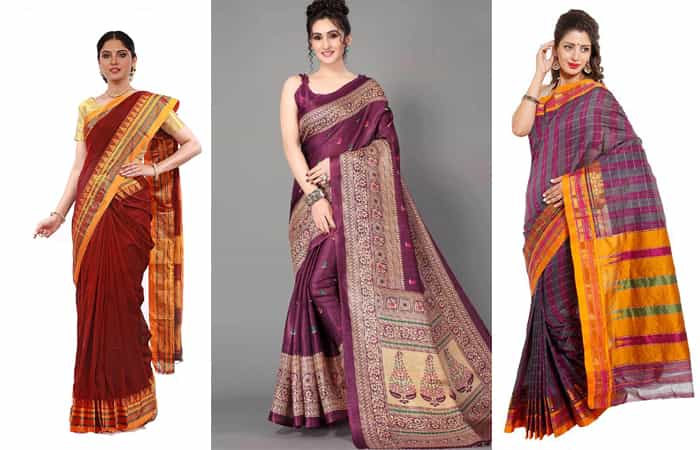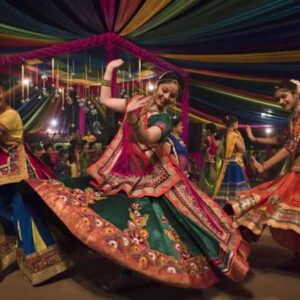One of the Southern states, Karnataka is known for its rich cultural heritage and grandeur. This fascinating state shares border with other states such as Telangana, Andhra Pradesh, Kerala, Tamil Nadu and Goa. The state sports a diverse scenic beauty ranging from the beauteous Coorg to the urban Silicon Valley-Bangalore. Fascinating historical sites like Hampi also dot the state. Furthermore, music, art and culture of the state speak of a rich heritage. In other words, the vivacious state of Karnataka has something to offer to every visitor. Each and every aspect of Karnataka contributes to the state’s beauty.
Karnataka’s traditional wears aptly portray the simplicity and refinement of the garbs of Southern India. The traditional dresses also mirror the rich culture of the state. The state has several diverse communities and each of those have their unique dressing style. The women here usually wear sarees while the men usually dress up in dhoti-kurta.
Down the years, certain changes and tweaks have occurred but the major part remains the same. In the rural areas of Karnataka especially the traditional attires are still worn.
Traditional Dress Of Karnataka’s Men

Men in the state wear attires such as the Panche, Angavastram and the Mysore peta.
Panche – Panche is a piece of cloth wrapped below the waistline. The panche is knotted at the waist. It is actually a kind of lungi and is also differently referred to as Veshti or Dhoti. Though nowadays men of Karnataka have embraced modern clothing like the T-Shirt, Shirt and Trouser, yet during traditional occasions the menfolk of the state wear the traditional Panche paired with a shirt on the top. These days, young men of the state wear the Kurta on top instead of the shirt. Silk or cotton material is used as the Panche. The Panche varies in length from mid-calf to ankles and comes in various colors and materials these days. The type of clothing makes a comfortable wear for the hot summer months as it allows air to pass between the clothing and one’s body.
Angavastram – Angavastram is a kind of stole or muffler which is placed around the neck or on the shoulder on one side. It is usually crafted out of cotton or silk. The Angavastram actually completes the Panche-Shirt look of the men of Karnataka.
Mysore Peta – Mysore Peta is a typical headdress worn by the men of Karnataka. It looks similar to a turban or pagdi and was worn by the royals of the state. Men of Karnataka wear the Mysore peta on all festive occasions. Golden threadwork is an integral element of the Mysore Peta. Some of the Petas worn by the men feature embellishments like beadwork, stonework and even feather decorations.
There isn’t much variety when it comes to dresses of men in Karnataka. However, each and every attire worn by the men of the state reflects strict traditional codes.
Traditional Dress Of Karnataka’s Women

Women of Karnataka prefer to flaunt their traditional saree look. The sarees they sport range from Mysore silk sarees to Kanchipuram sarees to IIkal silk sarees.
Mysore Silk Sarees – Mysore silk sarees are a highly popular traditional saree amongst the women of Karnataka. However, in the recent times women from the various other parts of the country have shown their deep love for the Mysore silk sarees and the popularity of these sarees have actually spread like wild fire countrywide. These sarees are rich crepe silk sarees known for being exceptionally lightweight. The extraordinary shimmer and brilliant Zari work featured in these sarees make them stand out most gloriously. Karnataka in fact boasts of being one of the major producers of mulberry silk in the entire country and the indigenous Mysore silk sarees are a brilliant manifestation of this rich silk. The craft of weaving Mysore silk sarees was actually patronized by the Sultans and Maharajas who ruled over Mysore in the yesteryears. Since then this craft has only grown to reach the pinnacle of immense success and popularity in the modern times. The distinct attribute of traditional Mysore silk sarees is that they have a base of solid color and are woven out of pure silk. The sarees’ base is dyed with any one particular colour and is mostly kept free from any sort of pattern or motif. This is done to highlight the beauty of the borders featuring intricate zari embroidery done with 24-carat real gold coated zari threads from Surat. Since real gold threads are used in these sarees the Mysore silk sarees are quite expensive. During traditional ceremonies the women of Karnataka definitely flaunt their best Mysore silk sarees. These sarees are in fact a symbol of class in Karnataka.
Kanchipuram Sarees – Kanchipuram sarees are highly elegant in terms of their designs. These sarees make a wonderful heritage weave. These sarees feature a significantly broad border decked with intricate handwork made from golden and silvery zari threads. The rich texture and smooth finish of the Kanchipuram sarees make them quite pricey. In Karnataka women drape these sarees on special occasions. Temple themed borders and saree bodies featuring floral motifs, stripes and checks are the chief features of the Kanchipuram sarees. In an authentic Kanchipuram saree, the saree’s body and pallu are crafted separately and then joined together artfully making use of zig-zag line which interlocks them.
Iikal Sarees – IIkal sarees are a popular saree type in the state. Women of Karnataka’s Bagalkote district were the first to wear the IIkal sarees. The sarees actually got their name from IIkal, a quiet and small town in Karnataka’s Bagalkot district. This town had been a prominent weaving center in the past and is known for its beautiful handloom sarees. These sarees feature a heavy pallu decked with prints and embroidery. These sarees come in vibrant colors such as peacock green, parrot green, yellow, pomegranate red. The body of the sarees presents patterns such as squares, stripes and small rectangles. These sarees can also come with a plain body. Similar patterns can be noticed on the saree’s bottom side too. These sarees come with an exceptionally broad border of nearly 4 to 6 inches. The borders are mostly of contrast colors which look utterly fascinating. There could be three main types of borders for the IIkal sarees such as the Paraspet, Gaadi and Gomi. The sarees feature temple architecture themed motifs, floral motifs, shells etc. Women who visit the temples and the women of rural Karnataka make sure to wear the IIkal saree. These sarees come in two major types of fabric- cotton and silk. Silk IIkal sarees are worn by the women of Karnataka during festive occasions while the cotton IIkal sarees is worn as regular wear by the women of the rural belts of Karnataka.
Giri Kumkum Bridal Sarees Of Karnataka – Bridal sarees worn by the brides of Karnataka are a special kind of saree crafted from Giri Kumkum. The texture of this type of saree fabric is truly unique. The color of these sarees resembles that of the ‘kumkum’ or vermillion used by the married Indian women to adorn their forehead and parting of their hair.
Young girl’s dress in Karnataka – Adolescent girls in the state wear the silk skirts paired with matching tops.
Traditional Dresses of the Kodagu community of Karnataka
Traditional dresses worn by the people of Karnataka’s Kodagu community are unique. These dresses set the people of the Kodagu community residing in Karnataka’s Coorg region apart from the other parts of the state.
Men Of The Kodagu Community Wear The Following Types Of Dresses:
Kupya – Kupya is a short-sleeved, collarless black tunic or overcoat that falls below the knee. It is either made of wool or cotton. This typically styled coat is worn by the Kodagu men on all formal occasions. When a white Kupya is worn, that symbolizes a place of honor for the wearer. Even bridegrooms don the white Kupya. The red colored kupya is worn during pujas and festivities related to Goddess Bhagvati.
Chele – Chele is a waistband or sash. The length of the chele is nearly 7 to 8 meters. It is usually crimson-colored and is embellished with intricate golden brocade embroidery and tassels. The chele is made to go around the waist twice or thrice. However, it is ensured that enough fabric remains at either ends so that a short and neat loop can be formed in the front. The chele is worn to secure the Kupya.
Vastra – The Vastra is a short kerchief of checked motifs worn on the head. Oneend of this headdress is made to hang loosely up to the neckline.
Mande Tuni – The Mande tuni is a cream colored brocaded turban worn on the head.
The Kodagu women wear sarees but the style of wearing is absolutely different. The saree pleats are beautifully tied on the back while the saree’s pallu is arranged over one’s shoulder. These sarees are available in both silk or cotton fabrics. Red Kodagu sarees are draped during all happy occasions.



